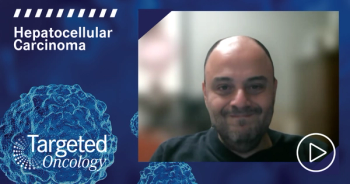
Atezolizumab/Bevacizumab Benefit Potentially Extends to Child-Pugh B HCC
Stacey Stein, MD, discusses the patient population and outcomes of the IMbrave150 trial of atezolizumab plus bevacizumab for patients with advanced hepatocellular carcinoma.
Episodes in this series
Stacey Stein, MD, associate professor of internal medicine at the Yale School of Medicine and assistant medical director of the clinical trials office at Yale Cancer Center, discusses the patient population and outcomes of the IMbrave150 trial (NCT03434379) of atezolizumab (Tecentriq) plus bevacizumab (Avastin) for patients with advanced hepatocellular carcinoma (HCC).
In the phase 3 trial, 501 patients were randomly assigned on a 2:1 basis to receive atezolizumab/bevacizumab or sorafenib (Nexavar). At a median follow-up of 15.6 months, the coprimary end point of overall survival (OS) was met with a median OS of 19.2 months with atezolizumab/bevacizumab compared with 13.4 months with sorafenib, a difference of 5.8 months (HR, 0.66; 95% CI, 0.52-0.85; descriptive P < 0.001). This was a significantly longer OS than what was seen in prior trials, Stein said.
According to Stein, trials of treatments for patients with advanced and unresectable HCC, including IMbrave150, focus on patients with Child-Pugh A cirrhosis or those without cirrhosis, as opposed to those patients with Child-Pugh B or C who are more likely to have poor outcomes regardless of treatment. These patients with a good performance status and liver function don’t represent the real-world population with HCC; however, several retrospective analyses of real-world patients have shown modest efficacy and responses in the Child-Pugh B population. Although toxicities need to be monitored more closely in these patients with poor liver function, they may also benefit from the combination.
TRANSCRIPTION:
0:08 | The OS was improved by a few months to a median OS of [19.2] months and these were numbers that we have never previously seen in this disease, so we really started to move the needle. In terms of the patient population that was selected, trials in HCC…usually focus only on patients with Child-Pugh A cirrhosis or patients without cirrhosis, and so overall, it's a well-compensated patient population with good performance status and good liver function, which may not always represent all of the patients we see in the real world in clinic. But there [are] some data that show that we're able to treat patients with Child-Pugh B disease without increased harm, and they still get a benefit from the regimen.









































